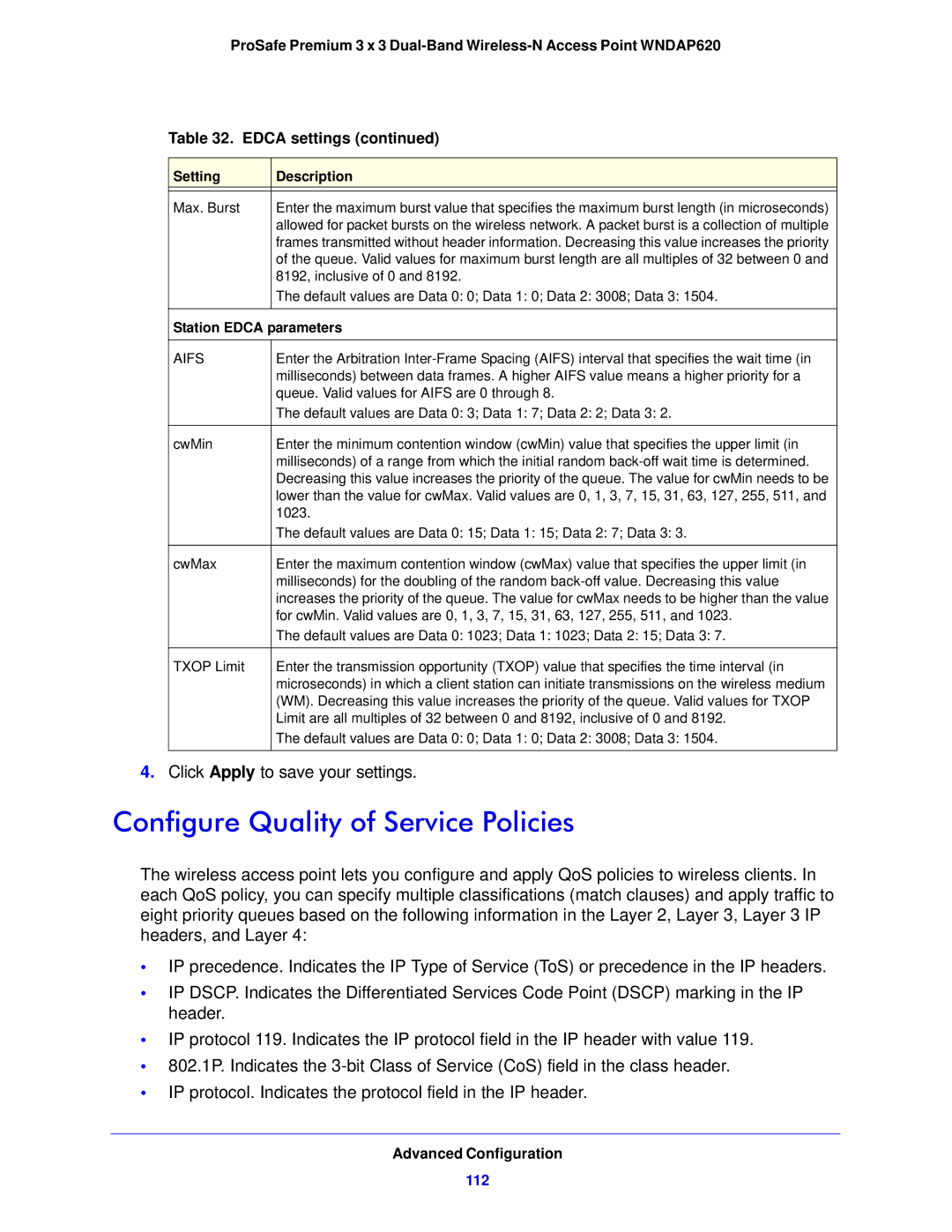
ProSafe Premium 3 x 3
Table 32. EDCA settings (continued)
Setting | Description |
|
|
Max. Burst | Enter the maximum burst value that specifies the maximum burst length (in microseconds) |
| allowed for packet bursts on the wireless network. A packet burst is a collection of multiple |
| frames transmitted without header information. Decreasing this value increases the priority |
| of the queue. Valid values for maximum burst length are all multiples of 32 between 0 and |
| 8192, inclusive of 0 and 8192. |
| The default values are Data 0: 0; Data 1: 0; Data 2: 3008; Data 3: 1504. |
|
|
Station EDCA parameters
AIFS | Enter the Arbitration |
| milliseconds) between data frames. A higher AIFS value means a higher priority for a |
| queue. Valid values for AIFS are 0 through 8. |
| The default values are Data 0: 3; Data 1: 7; Data 2: 2; Data 3: 2. |
|
|
cwMin | Enter the minimum contention window (cwMin) value that specifies the upper limit (in |
| milliseconds) of a range from which the initial random |
| Decreasing this value increases the priority of the queue. The value for cwMin needs to be |
| lower than the value for cwMax. Valid values are 0, 1, 3, 7, 15, 31, 63, 127, 255, 511, and |
| 1023. |
| The default values are Data 0: 15; Data 1: 15; Data 2: 7; Data 3: 3. |
|
|
cwMax | Enter the maximum contention window (cwMax) value that specifies the upper limit (in |
| milliseconds) for the doubling of the random |
| increases the priority of the queue. The value for cwMax needs to be higher than the value |
| for cwMin. Valid values are 0, 1, 3, 7, 15, 31, 63, 127, 255, 511, and 1023. |
| The default values are Data 0: 1023; Data 1: 1023; Data 2: 15; Data 3: 7. |
|
|
TXOP Limit | Enter the transmission opportunity (TXOP) value that specifies the time interval (in |
| microseconds) in which a client station can initiate transmissions on the wireless medium |
| (WM). Decreasing this value increases the priority of the queue. Valid values for TXOP |
| Limit are all multiples of 32 between 0 and 8192, inclusive of 0 and 8192. |
| The default values are Data 0: 0; Data 1: 0; Data 2: 3008; Data 3: 1504. |
|
|
4.Click Apply to save your settings.
Configure Quality of Service Policies
The wireless access point lets you configure and apply QoS policies to wireless clients. In each QoS policy, you can specify multiple classifications (match clauses) and apply traffic to eight priority queues based on the following information in the Layer 2, Layer 3, Layer 3 IP headers, and Layer 4:
•IP precedence. Indicates the IP Type of Service (ToS) or precedence in the IP headers.
•IP DSCP. Indicates the Differentiated Services Code Point (DSCP) marking in the IP header.
•IP protocol 119. Indicates the IP protocol field in the IP header with value 119.
•802.1P. Indicates the
•IP protocol. Indicates the protocol field in the IP header.
